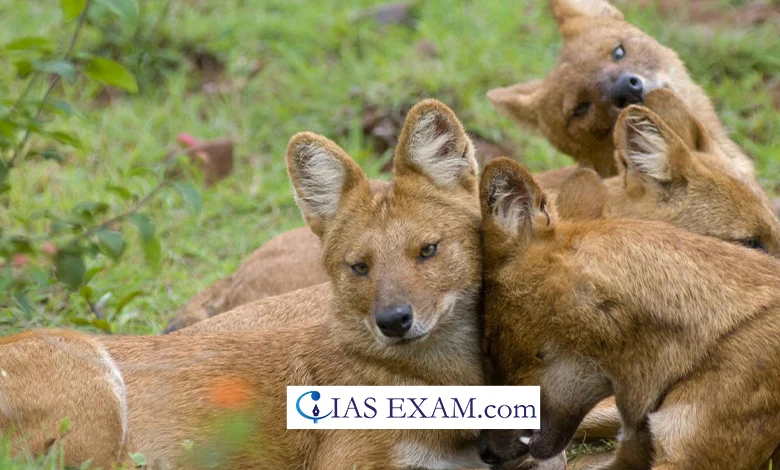Mange outbreak hits Asiatic wild dogs in Mudumalai
Syllabus: Health [GS Paper-2]

Context
The forest department is keeping a close watch on a mange outbreak among a pack of Asiatic wild dogs in the Mudumalai Tiger Reserve. They believe the disease may have been transmitted to the wild dogs from the nearby feral dog population.
Details
- A mange outbreak has been reported among the Asiatic wild dogs, also known as dholes, in the Mudumalai Tiger Reserve (MTR) in the Nilgiris.
- This skin disease, caused by parasitic mites, has affected at least three animals in a pack known to roam the Bokkapuram area, a region with high human-wildlife interaction.
Mange Disease
Mange disease, caused by parasitic mites, affects animals worldwide. It manifests in various forms, causing discomfort and skin issues. Understanding its causes, symptoms, diagnosis, treatment, and prevention is crucial for effective management.
Types of Mange
- Sarcoptic Mange: Caused by Sarcoptes scabiei mites, highly contagious.
- Demodectic Mange: Due to Demodex mites, often associated with immune system dysfunction.
- Cheyletiella Mange: Caused by Cheyletiella mites, less common, but contagious among pets.
Causes of Mange
- Mange is primarily caused by infestation with parasitic mites.
- These microscopic organisms burrow into the skin, triggering inflammatory responses.
- Transmission occurs through direct contact with infected animals or contaminated environments.
- Risk factors include overcrowding, poor hygiene, and compromised immune systems, making both domestic and wild animals susceptible.
Symptoms of Mange
- Mange symptoms exhibit variability, but normally cover severe itching, hair fall, skin problems and crusty and scaly lesions.
- Infected animals generally develop the characteristic extreme itching and scratching as well as a tendency to bite hard, which causes secondary bacterial infections.
- In extreme instances, mange may lead to more generalised conditions such as weakness and weight loss.
- Veterinary exams vary from general physical examination to radiographs and other special assessments that involve laboratory testing.
Diagnosis of Mange
- Diagnosing mange involves a combination of physical examination, skin scraping tests, and sometimes biopsies.
- Veterinarians inspect affected areas for characteristic signs like hair loss and skin lesions.
- Skin scrapings allow microscopic examination for mite identification.
- In challenging cases, biopsies may be necessary to confirm diagnosis and rule out other skin conditions.
Treatment of Mange
- Therapy normally involves a combination of mite-specific treatments and environmental management.
- Mites in surface epithelia can be treated with topical methods which include medicated shampoos and dips.
- Deeper infestations may be targeted by oral medications such as Ivermectin or Milbemycin.
- Treatment is just half the work; environmental management constitutes thorough cleaning of beddings and surroundings as a precaution against reinfestation.
- Bathing, trimming, and grooming regimens foster patients’ return to full health. Continuous veterinary care further establishes effectiveness of treatment and tracks for side effects as well.
Prevention of Mange
- Preventing mange involves maintaining good hygiene practices for pets and their environment.
- Regular veterinary check-ups allow early detection and treatment.
- Environmental cleanliness, including regular bedding changes and cleaning of living spaces, reduces mite transmission.
- Avoiding contact with infected animals, especially in multi-pet households or communal environments, minimises the risk of spread.
Asiatic Wild Dog
- The Asiatic wild dog, or dhole, is an endangered species found across central, south, and southeast Asia.
- They are known for their distinctive whistle-like calls and are crucial predators in their ecosystems.
- Protecting them from diseases like mange is vital for their conservation.
Conclusion
The mange outbreak in Mudumalai is a serious concern for the conservation of Asiatic wild dogs. It highlights the challenges of managing diseases in wildlife populations, especially in areas where human activities overlap with natural habitats. The forest department’s response and the community’s involvement are critical in controlling the outbreak and ensuring the health of this endangered species.
Source: The Hindu
UPSC Prelims Practice Question
Q.What is a primary method for managing a mange outbreak in a community?
a) Isolating infected animals
b) Vaccinating unaffected animals
c) Sterilising contaminated areas
d) Encouraging natural immunityAnswer: “a”





.png)



